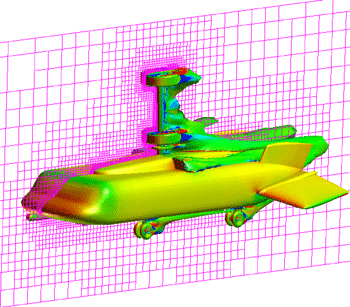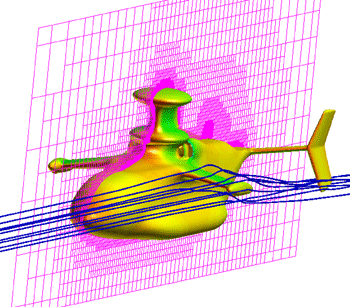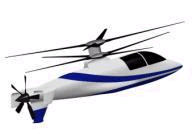 |
case study | aerospace |
Sikorsky Uses Harpoon to Solve Challenges of Coaxial Rotor Helicopter by Douglas Clark When a company claims to have solved a challenge that has bedeviled its industry for years, it must be ready to prove that its idea will really fly. And that, quite literally, is what Sikorsky Aircraft is prepared to do. A leader in the design and manufacture of advanced helicopters for commercial, industrial, and military use, Sikorsky has used new technology to help significantly improve the performance of the conventional coaxial rotor, a stacked pair of high-performance counter-rotating rotors. The company is now preparing to demonstrate its new coaxial rotor, known as X2 Technology™ demonstrator*, with the world of aviation as its audience. Sikorsky is also hard at work applying its X2 Technology solutions to practical aviation challenges, as it perfects conceptual designs of two military heavy lift aircraft that employ the suite of X2 Technology solutions. Two rotors are better than one T. Alan Egolf, an engineer and Supervisor of Aerodynamic Methodology at Sikorsky, has worked with numerous coworkers on the effort to reengineer the conventional coaxial rotor. Egolf explains that “coaxial rotors have been in use for years and are currently manufactured by a few manufacturers.” Although the basic concept of stacked rotors presents a number of important advantages over a single-rotor design, there are other challenges associated with coaxial rotor systems that have limited their use for high-speed applications. Among the advantages, coaxial rotors generally make for a more stable flight. When designing a single rotor helicopter, engineers must ensure that the torque produced by the main rotor is offset by a tail rotor or vectored air. Otherwise, the body of the aircraft will spin contrary to the direction of rotation of the main rotor—clearly a dangerous situation. In a coaxial design, the stacked rotors turn in opposite directions, offsetting one another’s torque to produce stable flight conditions. Another design advantage is ground safety. Since coaxial-rotor helicopters do not require a tail rotor, they are safer to approach while rotors are still in motion. This is a particularly important advantage for military applications, where circumstances may not allow time to stop rotors before personnel approach or exit the aircraft. Helicopters powered by coaxial rotors are also generally capable of higher speeds or able to bear greater weight than single-rotor aircraft. This superior performance is due to the sheer physics of how rotors work. Every conventional helicopter has a maximum speed at which it can no longer produce sufficient laterally balanced lift and maintain controllability on the rotor due to retreating blade stall. While these same phenomena affect the individual rotors of coaxial designs, the effects of one rotor are essentially canceled out by those of the other rotor, allowing for higher do-not-exceed speeds that are limited more by engine power and design structural limits than by control issues. Improved speed is exactly what Sikorsky has come up with in its current work. Speaking about the direction of the company’s current work with X2 Technology systems, Egolf explains that “Sikorsky is working on two different coaxial rotor concepts under conceptual design studies for the government. Currently, we’re working on the X2 Technology Crane (X2C) and the X2 Technology High-Speed Lifter (X2HS).” The X2C is intended to lift exceptionally heavy external loads, while the X2 HS can take full advantage of coaxial rotors’ high performance to move heavy loads or troops stowed internally at high speeds. . Advantages and challenges Of course, with coaxial rotors’ great advantages come engineering challenges. The hub on which the rotors are mounted is complex since it bears two rotors that turn in opposite directions around the rotor shaft. In addition to designing a mechanically efficient hub, designers also must take into consideration the drag and lift properties of the assembly, just as they do for every other part of the craft. This is because the hub drag of a coaxial system is more than that of a single main rotor hub. To assess the highly sensitive area of the rotor hub and the pylon, which is the housing directly beneath the rotors, the team is using CFD methods that use high-resolution FLUENT meshes to achieve the highly accurate calculations that are necessary for even the most preliminary work on this area of the helicopter. While this accuracy is critical for the hub and pylon, it is too time consuming and expensive to be practical in the preliminary design of many other areas of the helicopter. For all but the most sensitive areas, engineers throughout the industry generally derive needed calculations from panel methods during the preliminary stages of design. But while using panel methods is reasonably fast and inexpensive, it also allows a considerable amount of the engineer’s subjectivity and speculation to creep into the calculations. That’s because panel methods cannot account for flow separation or lift without user-selected models of these phenomena. Automatic grid generation adds efficiency and savings Always looking to improve on their design and engineering process—particularly through the use of new technology—Sikorsky has adopted a new method for much of its preliminary design work that allows them to tap the power of CFD methods in a fast and cost-effective manner. As Egolf and his colleagues assess the aerodynamic characteristics of the two conceptual X2 Technology aircraft , they’re drawing on Harpoon, an automatic grid generation tool from Sharc, to help support and improve the design process. By combining Harpoon-generated grids with FLUENT, the team is studying the fuselage aerodynamics for the two conceptual X2 Technology aircraft. “The value of Harpoon,” says Egolf, “is that it provides a very quick grid adequate for the level of fidelity of prediction that we’re interested in to support our preliminary design work. ” While the Harpoon grids are somewhat lower fidelity than the grids used in later design stages, they are cost-effective and provide quick results that, when combined with FLUENT, are far superior to traditional panel methods. “During this preliminary design phase,” Egolf notes, “this is an acceptable trade off for us in cost vs. fidelity.” Harpoon has saved the engineering team considerable time and, as a result, money. “If the designer changes something,” says Egolf, “we want to be able to regrid quickly—which Harpoon allows us to do—and get results in a timely manner so we can have an impact on our schedule.” Sikorsky has taken advantage of Harpoon’s speed and cost-effectiveness in a number of areas. In addition to using Harpoon to understand the aerodynamics of a fuselage and refine its design, Egolf and his colleagues have also used Harpoon to study the interactions of the fuselage flowfield with other components of the aircraft, such as the engines. Early in the program, CFD solutions based on Harpoon grids indicated significant problems with the sizing of airflow inlets and exits. The discovery allowed engineers to catch the problem early on and redesign portions of the fuselage accordingly. Later in the program, higher-fidelity CFD simulations indicated that some additional refinements to the inlet design were needed. Instead of immediately rerunning the more costly and time-consuming high-fidelity CFD simulations once the redesign was completed, the engineers used Harpoon to run a quick study on the air inlets and check the impact of the redesign. Just two hours after receiving the redesigned fuselage parts, the engineers had an answer as to whether the new design was effective. Pursuing Harpoon’s time- and cost-saving advantages has made a significant difference in Sikorsky’s work on the two conceptual X2 Technology aircraft. Of course, the use of the latest computer technology is certainly nothing new at Sikorsky. An ongoing pursuit of the best technology available helps explain how Sikorsky has succeeded thus far in producing some of the world’s finest aircraft. And it’s also part of the company’s plans to continue to raise the bar in the world of helicopter aviation. *X2 Technology is a trademark of Sikorsky Aircraft Corporation. More Information The Man Behind the Machine If the name Sikorsky sounds familiar, that’s because engineer Igor Sikorsky was the inventor of the helicopter as we know it. Read more about his work and the evolution of the helicopter here. Igor Sikorsky drew inspiration from those before him, including Leonardo da Vinci, the Renaissance genius whose sketches show early conceptions of a helicopter-like flying machine. |
Harpoon grid of X2 Technology crane (X2C); fuselage with surface pressures and iso-surfaces of total pressure Harpoon grid of X2 Technology high-speed lifter (X2HS); fuselage with surface pressures and streamlines X2 Demonstrator side view
X2 Demonstrator "flying" |




